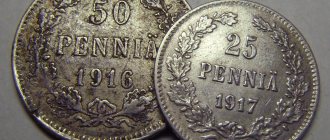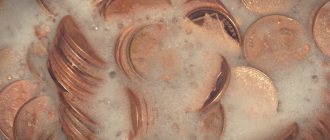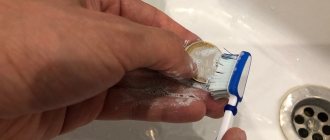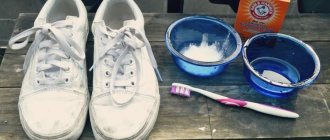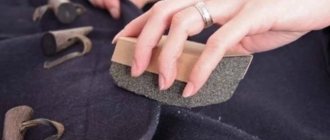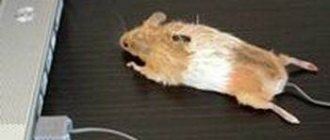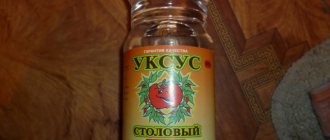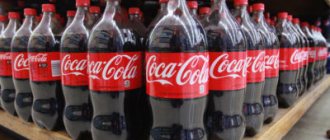Cupronickel coins are quite unusual items issued during the Soviet Union. Unfortunately, almost all banknotes from the period 1931-1957, which were found in the mines or found in home bins, have changed their appearance and are difficult to clean. But this does not mean that it is impossible to achieve a decent result. Before trying any of the methods presented below, it is important to understand that it is unlikely that you will be able to clear all coins, and a 100% result is not always possible.
Features of the content of copies
High humidity and exposure to direct ultraviolet radiation are not allowed. Properly storing coins at home means using special organizers. They differ in materials and cost.
- Albums. They come with a fixed number of sheets and replaceable ones. Suitable for short-term storage. It is recommended to choose plastic options. PVC albums should be avoided.
- Holders. Envelopes made of cardboard with transparent walls. They are stapled or glued to paper. They need to be replaced with new ones twice a year, which is not very convenient.
- Envelopes. Popular with newbie collectors. There are paper or plastic. They are easy to use, inexpensive, but need to be changed frequently.
- Capsules, weak. The most reliable storage methods, but they are expensive. The products are sealed hermetically. Information about the coin is indicated at the top.
- Cases. They are presented in a wide variety, but have a high cost. Provide the highest quality storage conditions. The design includes shelf tablets, and coins are placed in separate cells.
Muntzkabinets are similar to cases. Made from expensive wood. In most cases, they are used not as functional, but as status storage.
Restoration and cleaning of coins of the RSFSR and the USSR from cupronickel using mechanical cleaning
French (French), Moscow, 01/31/2016 16:39
Gennady Gennadievich (smartbibber), Yekaterinburg wrote:
The result is amazing. Is it really just a scraper? And how does the surface quality compare to chemicals?
Yes, Gennady Gennadievich, only a scraper (Burs sharpened on a diamond disk under a magnifying glass in the shape of a triangle is a difficult task, but it is possible) The surface of the coin is, of course, smooth, almost like gloss, which makes it difficult to photograph the coin, because all the light from the flash is reflected in the very coin and the coin turns into a small sun))) Here is an enlarged photograph of this coin... and chemistry is not capable of this, because it destroys and you can bring the coin to evenness in some ways, such as with attachments from a drill, but then the drawing cried, because it will erased/smoothed beyond recognition (the relief will disappear), although in my case it was not without vinegar and salt, because this composition in the right proportion helped me get rid of the dark color of the coin.
clubklad.ru
What cannot be affected
You can clean old coins efficiently and quickly if you know what substances and tools should not be used.
- Concentrated solutions. It is not recommended to add nitric, acetic, sulfuric or hydrochloric acids in large quantities. They are capable of melting the embossing and design, which will lead to damage to a valuable specimen. It is better to treat with a special product “Asidol” or use “Trilon” powder.
- Sandpaper. Dangerous for bronze and copper products, as it destroys the patina. Sandpaper can change the relief of the embossed surface.
- Wire brush. Damages the surface of the coin. It is recommended to use brass, with artificial, natural bristles.
Too high temperatures can also destroy metal.
4 more taboos
When looking for a way to polish coins and give them shine and shine, it is important not to overdo it. Careless handling of tools or cleaning agents can lead to damage to precious items. To prevent this from happening, you need to remember four taboos.
- Use of strong abrasives. If the coin is valuable, do not use washing powder, soda or other harsh substances for cleaning. This may cause scratches and damage to the pattern.
- Boiling damaged products. If there are cracks or signs of corrosion, do not expose the product to high temperatures.
- Use of dangerous methods by beginners. If you are not a professional in numismatics, you should not clean coins with electrolysis or harsh chemicals.
- Prolonged exposure to cleaning products. If you expose a coin to substances longer than specified in the instructions, this may lead to damage to the structure of the product.
If you are just starting your journey as a numismatist, remember that cleaning coins at home cannot return them to their perfect original appearance. Therefore, if you have valuable specimens on hand, it is important to protect them from darkening and contamination. Before hiding the product in the organizer, thoroughly wipe it with alcohol and lubricate it with Vaseline.
In the period from 1931 to approximately the sixties of the last century, coins were made from a copper-nickel alloy. Over time, such products become covered with a film of oxidation, turning from red to dark brown. Cleaning nickel coins will not help restore them to their original pristine appearance, since it always damages the surface to a certain extent, but it may well make them presentable.
How to Clean Coins: 5 Homemade Solutions
Chemical reagents allow you to clean coins from rust and oxidation. The main components used are acids, baking soda, ammonia, washing powders and soap. Unlike other methods, removing dirt using hydrochloric acid is a labor-intensive process that requires caution. It is imperative to treat with alkali to neutralize the reaction.
Vinegar
Description. This is a fast-acting cleaner for copper coins with black and yellow deposits. The method is suitable only for those specimens that are not of great value. You can add shine to old coins that are not exclusive or rare items. The most convenient option is to put metal money in a 10% vinegar solution. There is another way to get rid of dirt that has accumulated over the years.
Procedure
- Add a small pinch of salt to a quarter glass of vinegar. If you need to process a lot of products, then take half a glass of vinegar and 15 g of salt. Stir until all particles dissolve.
- Place coins in the solution. We make sure that they do not touch each other. We wait five minutes.
- We take it out. If the stains are not removed, then carefully wash them with a brush made of artificial or natural bristles.
- Rinse with running water.
Ammonia
Description. A 10% ammonia solution from a pharmacy is suitable. Since it is characterized by a persistent pungent odor, work is carried out in a well-ventilated room. Allows you to clean aluminum bronze coins from pink stains. And also from copper and silver - from green, purple, brown plaque.
Procedure
- Pour ammonia into a container. We place the products in it. We turn them periodically. We don’t get it right away and suddenly.
- After we have finished removing the dirt, gradually pour water into the solution to reduce its concentration of the active substance. When it becomes weak, take out the metal money and rinse it with water.
- You can wipe with a soft cloth or leave to dry.
- We repeat the procedure if the copies are not cleared the first time. But we do this only for products that do not have damage, for example, chips or cracks.
Soda
Description. Using soda as the main alkaline product, do not forget that it can negatively affect products. It is recommended to make a weakly concentrated solution and carefully monitor the reaction of the metal. Great for those times when you need to clean silver coins from green deposits.
Procedure
- Take a spoonful of baking soda and add a little water to it until a paste forms.
- Apply the mixture to the surface of the coins.
- We get rid of dirt using a soft brush.
Citric acid
Description. You can clean coins to make them shine using a budget-friendly solution – lemon juice. The solution can have an aggressive effect, so we carefully monitor the reaction.
Procedure
- Dilute citric acid in water so that no crystals remain at the bottom.
- Place the coins and swap them so that all sides are clear.
- Wash with water and dry.
Cleaning bimetallic coins involves using a solution in which a glass of water is mixed with two teaspoons of citric acid. We keep the products in it for no more than ten minutes. Wipe with a soft old toothbrush.
Soapy solution
Description. One of the simplest and cheapest options. In addition, laundry soap is absolutely safe for collectible items.
Procedure
- Pour hot water into a container and rub soap into it. We wait until the detergent dissolves.
- Place the products into the mixture. Cover the container with something. Leave for two to three days.
- We take out the coins and clean them with a soft old toothbrush.
It is acceptable to replace soap with washing powder. But it is effective only for light stains. We immerse metal products in the solution for several hours. Then rinse with water and dry.
And yet vinegar
The vinegar method, with all its “barbaric” essence, is still effective, and in some cases the only possible one. But you should understand that everyone uses all the proposed methods at their own peril and risk. The essence of the method point by point:
- Buy a brass brush or sponge.
- Take a small non-metallic container and pour vinegar solution into it, based on the proportion of 1 part undiluted acetic acid to 10 parts water. Sufficient liquid depth is 5 mm.
- Place a coin in the solution and every 12 hours remove it from there and use a brush to remove all flaking oxides from both sides and the edge. Repeat as many times as the state of the instance requires (usually 3-10 cycles).
- Wipe the coin with alcohol and put it in a warm, bright place to dry for several days.
After lying there, the coin will begin to turn gray and lose its shine; this is a natural process. As for scratches, they will not be noticeable visually, since the brush is still soft. But, if you look under magnification, they, of course, will be visible. If the oxides have “eaten” part of the metal, then after they are removed the surface will be unsightly and uneven, like the surface of the moon - nothing can be done about this, because patina is not a coating, but a part of the metal. If drying is poor, rainbow stains may appear on the surface after several months. And one more important detail: vinegar must be of high quality and comply with GOST.
And finally, it must be said that not all copper-nickel coins covered with patina (oxides) need to be cleaned. If the surface of the coin disc is covered with a thin and smooth, so-called noble or cabinet patina, there is no need to remove it. This is an indicator of the age and authenticity of a collector's item.
Methods for silver
For products of low standard, dry cleaning is suitable. They are treated with Trilon B. The solution removes green plaque. More valuable specimens require careful handling. Having decided to polish the coins, we try to process them in such a way that they do not come into contact with each other. After the procedure, be sure to rinse in warm water. Let's consider two non-standard methods.
- The water left over after boiling the eggs. Suitable for removing light stains and providing shine. Place the money in warm water and let it sit for a few minutes. In this way you can clean white Soviet coins. The method is gentle and does not cause harm.
- Formic acid. We take a 5% solution and put specimens from the collection into it. Afterwards, carefully clean with a soft brush. If this is cleaning USSR coins at home, then the method is effective as it removes traces of oxidation.
Silver coins should not be immersed in hot water or boiling water and then immediately rinsed with cold water.
Hydrochloric acid
From the chemistry course it is known that hydrochloric acid is an effective means for dissolving oxides. You shouldn’t be afraid of this name; analogues of hydrochloric acid are used in the household, in particular, for cleaning toilets (“Toilet duckling”). You can use this remedy by dropping a coin into it, but it is important to maintain the correct time.
If it lies in the “duckling” for several hours, that very unpleasant and uncharacteristic pink tint for which copper is responsible may appear on the metal. It is important to correctly evaluate the initial appearance of the coin. If it is not very damaged and has that same silver-white color, such cleaning can only ruin everything. And, as in the case of table vinegar, the acid can “eat” the reliefs, which is completely undesirable.
GOI paste is another product that is only suitable for inexpensive coins that are not very valuable in terms of rarity. If you have a real rarity in your hands, this method cannot be used. Abrasive particles of the composition will not only erase the patina, but also spoil the relief, its clarity and even small details. In addition, GOI paste tends to give metals an unnatural shine, which is not at all characteristic of metal money that was stamped almost a century ago.
For coppers
The choice of processing method depends on the color of the patina. If it is cherry or brown, then we use an ammonia solution; if it is yellow, we need vinegar; if it is white, we use distilled water. You can clean a copper coin from black deposits at home using two means.
Vaseline oil
- Pour oil into the pan. (The standard volume of a bottle is 40 ml. Therefore, we determine the amount of oil based on the number of coins requiring processing).
- We put it on fire.
- Throw the products into boiling oil and hold them until the coating disappears.
- After boiling, cool them and wipe with alcohol.
- Dry with a soft cloth.
Peroxide + ammonia
- For 200 ml of water, take a teaspoon of ammonia and 30 ml of hydrogen peroxide.
- Mix the components and place the coins in the prepared solution for no more than 15 minutes.
- Afterwards, gently wipe them with a soft cloth.
Copper coins can be boiled in laundry soap. This is a gentle option that allows you to preserve collectible items without harming them.
Chemicals
Manufacturers offer ready-made cleaning products for metal money with different compositions; the price of such solvents ranges from 100 to 350 rubles per bottle.
Let's learn how to clean coins without blowing your budget, and what chemicals will help you cope with the task:
- Using concentrated nitric acid. Wear gloves. Prepare two containers. Pour 50% acid into one, hot water and soap solution into the other. Using tweezers, lower the coin, without releasing it, into the acid for 2-3 seconds, and then immediately into the soap solution.
- Using an aqueous ammonia solution. Open the window, put on a protective mask. Pour the ammonia solution into the glass and immerse the penny for 15–20 seconds. Remove it, rinse with water, dry thoroughly and polish until shiny.
- Pour 2 tbsp into a glass. spoons of 9% vinegar add 2 tbsp. spoons of table salt, stir and immerse the money in the pulp for 5 minutes, remove it, and additionally rub with the resulting mixture. Rinse the cleaned coin with warm water, dry and polish.
When working with chemicals, do not forget about your own safety.
For bronze
The same methods apply to bronze products as for copper ones. Let's look at two more folk methods that have gained popularity among numismatists.
- Coca Cola. The drink acts as a dirt solvent. It holds coins for a week. Afterwards they need to be washed in water. Based on the reviews, the results are impressive.
- Bath cleaner. We choose products without aggressive components. We lower the products for a maximum of a couple of minutes. Rinse well with water.
You can also clean bronze coins using hyposulfite. A 10% solution is suitable.
Electrolysis is not for everyone
Another method of cleaning USSR copper-nickel coins will require a power source, which could even be a phone charger. The coin must be attached to the cathode (negative), the source must output up to 12 watts. A solution with salt (one tablespoon) or soda (two tablespoons) is added, into which the part is lowered. The current is applied from several minutes to an hour, depending on the desired result and the degree of oxidation of the product.
It is important to know that this method should not be used on coins that have noticeable surface damage. The result is accompanied not only by getting rid of oxide, but also by the manifestation of all cavities and flaws.
For cupronickel
In its properties and characteristics, cupronickel is similar to a noble metal, so over time it acquires a black coating and oxidizes. The following methods allow you to restore shine to products without damage.
Dish cleaning powder
- We wet the products in water and apply the product to them.
- Use a soft sponge to rub the surface on both sides.
- Leave for a few minutes and wash off.
Ash
- If there is a smoker in the house, then we collect ashes from tobacco products.
- Dip the coins in water and sprinkle with ashes.
- Leave for 20 minutes and rinse.
Any cleaning of cupronickel coins, like the processing of other metals, requires compliance with safety rules. Don't forget to protect your hands - wear gloves.
— chemistry: from cheap to expensive
A copy before cleaning
Plans and dreams of a collector * * * * * Harsh reality at the end of the process
It’s worth gaining experience on the cheapest copies, which you wouldn’t mind throwing away later. At this stage, many illusions are shattered. It seems that after cleaning the coin will simply change color from black or green to its original color and will begin to resemble the specimens resting in museum cases. The result, most often, is something else: a disgusting-looking corroded coin field and a crumpled relief beyond recognition. And all because patina is not a coating from the outside, but part of the coin itself. It smooths out unevenness and hides imperfections. By removing it, you will expose all hidden defects. Sometimes dry cleaning removes almost the entire relief, which has faded into patina over time, and what we see is no longer a coin, but a strange circle on which we can’t make out either numbers or inscriptions.
Have you decided to cleanse? Be sure to determine what metal the coin was minted from. A product that is ideal for one metal will irrevocably destroy others, if you do not take into account the composition of the ingredients included in it. The most difficult coins to clean are those made of tin or lead. These are very soft metals. Both abrasive cleaning, which erases the relief, and most chemicals are contraindicated for them. But aluminum coins are easy to clean. The film that forms on them quickly replaces the original shine with unsightly turbidity. But it can be easily removed with a simple composition (experts recommend 50 grams of borax, 5 grams of ammonia per 1 liter of water). After such cleaning, the aluminum is not washed, but dried immediately.
Aluminum bronze and brass are easy to clean with modern kitchen chemicals. However, it should be remembered that chemistry washes away copper, and the color of a golden brass coin becomes pink or scarlet (newbies, seeing such a specimen, immediately drag it to numismatists under the guise of a rare copper sample). Therefore, using experiments on cheap coins, compose your chemical series according to the degree of impact on the coin. Initially, try to correct the situation with a weaker composition and only then move on to stronger reagents.
Copper, after losing its patina, acquires a sharp reddish tint. Therefore, when working with copper, you must either accept the coin as is, or move on to the next stage of the collector’s basic skills - independently applying patina, which returns the coin to its usual chocolate color.
Trilon-B for uniform oxidation
Trilon-B is a strong cleaning agent. In some cases, the product will damage the material, but with copper-nickel coins there is nothing to worry about. It is best to choose this cleaning method for cases of uniform oxidation coverage.
The substance can be dissolved in water in a ratio of one to ten. The solution effectively cleans the coin: the duration of the procedure depends on the degree of contamination and the desired result. After cleaning, wash the coin with soap and hot water.
GOI paste
The method significantly damages the surface of the products, like any cleaning with abrasives. If the coins are rare and are being cleaned for sale, cleaning with GOI paste is excluded: polishing removes a thin layer of the surface, erases small details and the products lose their value.
GOI paste is usually applied to a soft rag, sometimes moistened with gasoline. Before you start polishing, you need to wipe a layer of paste on an unnecessary surface or object so that large pieces disperse and do not scratch the part.
In general, there are plenty of ways to clean nickel coins at home. Depending on the degree of contamination, you can choose the appropriate one.
In Russia, or more precisely, in the territory of the former USSR, an alloy of copper and nickel was used to make coins from 1931 to 1935. This alloy is considered wear-resistant, but it also has one drawback - over time, a layer of red-brown oxide forms on the coins. It is quite difficult to clean coins from it, but at home you can prepare products that will make cleaning copper-nickel coins of the USSR much easier.
USSR copper-nickel coin
